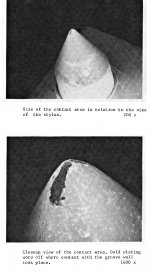Seems that dogs will tolerate a lot of two-legged friend's stupid ideas.Seems you can teach a dog anything.
Last edited:
Mine told-me that DAC 24-96 was a requisite.My dog, Swiss shepherd 40 kg, smarter than me.
Nothing for me to say about diy audio, dogs are more interesting.
I know some humans who should think first about learning something from them ;-)Seems you can teach a dog anything.
Hans: I think your contact area is out by at least a factor of 10. See Stylus Tip | Adamant Namiki Precision Jewel Co., Ltd.
The stylus manufacturers specify the "zones" at the tip, but the contact area when tracking a groove will be larger than that because of the deformation (hopefully just elastic one) of the vinyl.
And it depends on the tracking force actually applied; as said before there are still cartridges in use (even newly bought) with recommended tracking forces of 3 - 5 gr.
Last edited:
My dog, Swiss shepherd 40 kg, smarter than me.
Nothing for me to say about diy audio, dogs are more interesting.
Aha! Now we know who really designs those low distortion amps!
😉
DBT:Aha! Now we know who really designs those low distortion amps!

(Dog blind test)
The stylus manufacturers specify the "zones" at the tip, but the contact area when tracking a groove will be larger than that because of the deformation (hopefully just elastic one) of the vinyl.
If the hypothesis is that a modulated groove exerts a large increase in pressure and hence increased deformation, one should see a change in crosstalk with left or right only modulation because the force on the stylus is applied at a 45 degree angle and there is an equal part which vectorially is into the unmodulated channel.
A line of experimentation that I have not seen elsewhere is taking a fixed test tone and varying the RPM of the turntable and comparing that with a constant velocity sweep at constant RPM. This compares constant amplitude vs constant velocity and there should be a large difference in the acceleration forces vs frequency.
Another point, I unfortunately never saved a purely geometrical computation of distortion vs stylus geometry that was published somewhere. IIRC the computation vs measurement was fairly good without any correction for increased deformation with modulation. As Lucky pointed out the distortion would increase rather dramatically.
Last edited:
Though not related to record wear or deformation. In following B&K Technical Review link on page 35 (Fig. 8) shows difference in response between stylus-groove and stylus excited by accelerometer. Can we deduce something out of it ?
They have not mentioned any difference between artificially generated response by accelerometer and running stylus in groove test record.
https://www.bksv.com/media/doc/TechnicalReview1976-2.pdf
They have not mentioned any difference between artificially generated response by accelerometer and running stylus in groove test record.
https://www.bksv.com/media/doc/TechnicalReview1976-2.pdf
I'll give it a try to redo my earlier attempt in getting some better insight into the matter of pressure on the LP walls and whether this pressure may exceed the yielding point causing that plastic flow will set in.
Reason to redo is because:
1) more accurate info regarding the contact area came from Bill, from Jakob, from a SEM picture of a spherical stylus and from a very good AES paper published by Bastiaans. The latter 2 sources see image 1 and 2.
For this posting a 60um2 contact area has been used, exactly what can be seen in image 1 and also in the Bastiaans calculation, where the real contact area was calculated and measured for a spherical stylus with a radius of 17um.
2) Bastiaans also had a more accurate yield point figure of 14,500 psi or 1000 Kg/cm2 for Vinyl.
3) I also corrected a silly 10 fold calculation error in the pressure.
4) Below I assume a stylus riding a blank groove. Signal modulation will further complicate things.
But given the fact that a 1Khz@0dB signal causes ca. 50G peak stylus acceleration having a moving tip mass of around 1mg or below, the pressure on the walls will probably still be dominated by the 2gram stylus force.
Comments are still welcome.


Reason to redo is because:
1) more accurate info regarding the contact area came from Bill, from Jakob, from a SEM picture of a spherical stylus and from a very good AES paper published by Bastiaans. The latter 2 sources see image 1 and 2.
For this posting a 60um2 contact area has been used, exactly what can be seen in image 1 and also in the Bastiaans calculation, where the real contact area was calculated and measured for a spherical stylus with a radius of 17um.
2) Bastiaans also had a more accurate yield point figure of 14,500 psi or 1000 Kg/cm2 for Vinyl.
3) I also corrected a silly 10 fold calculation error in the pressure.
4) Below I assume a stylus riding a blank groove. Signal modulation will further complicate things.
But given the fact that a 1Khz@0dB signal causes ca. 50G peak stylus acceleration having a moving tip mass of around 1mg or below, the pressure on the walls will probably still be dominated by the 2gram stylus force.
Comments are still welcome.
I) That the PU needle becomes very hot because of friction, even causing the Vinyl to melt, can be easily rejected with simple math, showing that no more than 3mW/sec results from this friction using a friction coeff. of 0.3, a needle pressure of 2 gram and the speed on the outer track of a 33 1/3 rpm LP.
Given the very short contact time, this is way too low energy to let the vinyl melt. The small amount of generated heat will be absorbed by the LP and by convection to the air from the cantilever.
II) However the Ice Skating thesis that several authors have mentioned in the past, seems not that mad at all.
The yield point where Vinyl goes from elastic behaviour into a fluid plastic phase lies at ca 1,000Kg/cm2.
This figure is independent of the surface area as far as I can find.
Now taking a 2 gram needle force and a contact area of 60um2 that includes the wall deformation because of the elastic properties of vinyl, causes 0.0233gr/um2 perpendicular to each individual wall.
This translates into 2,333Kg/cm2 or well above the yield point of 1,000Kg/cm2. That would imply that the stylus lies on a thin layer of fluid plastic like an ice skater.
III) At the same time the consideration that using a fluid at playback may negatively influence the proces of exceeding the yield point seems not at all that unlikely, although some authors disagree (Hirsch, Aes convention 1974).
It could even be that because of aqua-surfing lift, the wall pressure area becomes (much) larger and the plastic liquify phase is not even met, resulting in a needle scraping some vinyl of the groove walls instead.
When examining LP's always been played with Lencoclean, an unbelievable amount of a very fine smudge, almost like grease, is on the bottom of the grooves, not at all like the dirt to find in always dry played LP's.
Could this smudge be composed of vinyl particles ?
Hans


Scott,If the hypothesis is that a modulated groove exerts a large increase in pressure and hence increased deformation, one should see a change in crosstalk with left or right only modulation because the force on the stylus is applied at a 45 degree angle and there is an equal part which vectorially is into the unmodulated channel.
A line of experimentation that I have not seen elsewhere is taking a fixed test tone and varying the RPM of the turntable and comparing that with a constant velocity sweep at constant RPM. This compares constant amplitude vs constant velocity and there should be a large difference in the acceleration forces vs frequency.
Another point, I unfortunately never saved a purely geometrical computation of distortion vs stylus geometry that was published somewhere. IIRC the computation vs measurement was fairly good without any correction for increased deformation with modulation. As Lucky pointed out the distortion would increase rather dramatically.
When you can find the time, you should read the Bastiaans AES paper that I just referred to.
Several of your questions will be answered in detail.
Hans
I like the trick of gold plating the stylus to ascertain the contact area.
If the vinyl were undergoing elastic<>plastic phase changes each time the stylus passed a particular point, would there not be micro-fractures on the vinyl groove walls?
Just a thought.
If the vinyl were undergoing elastic<>plastic phase changes each time the stylus passed a particular point, would there not be micro-fractures on the vinyl groove walls?
Just a thought.
Scott,
When you can find the time, you should read the Bastiaans AES paper that I just referred to.
Several of your questions will be answered in detail.
Hans
I'm not really interested in spending money to research this anymore. I was thinking I probably have only listened to a few LP's >50 times. It's hard these days to even get the energy to take everything down and set up for non-RIAA playing of test tracks.
BTW does that paper treat the time factor?
Been away for awhile and found it's suddenly about dogs.
My dog "Ozzy" : Boxer (white) 35 kg ( 77 lbs) pure muscles.
(he sadly passed away, pictures are from his last summer)
don't know why some pictures are 90 degrees wrong. I guess it's about phase shift in digital files. LOL
My dog "Ozzy" : Boxer (white) 35 kg ( 77 lbs) pure muscles.
(he sadly passed away, pictures are from his last summer)
don't know why some pictures are 90 degrees wrong. I guess it's about phase shift in digital files. LOL
Attachments
Last edited:
Indeed. I'm very surprised to see some of the "objectivists" of the forum showing such an interest to Vinyls.I'm not really interested in spending money to research this anymore.
Would their faith in the cold objectivity of the measurements numbers suddenly be subjected to the same criteria than their audiophile enemies ?

Last edited:
I'm not really interested in spending money to research this anymore. I was thinking I probably have only listened to a few LP's >50 times. It's hard these days to even get the energy to take everything down and set up for non-RIAA playing of test tracks.
BTW does that paper treat the time factor?
In that case, I can probably give you an answer to your question:
If the hypothesis is that a modulated groove exerts a large increase in pressure and hence increased deformation, one should see a change in crosstalk with left or right only modulation because the force on the stylus is applied at a 45 degree angle and there is an equal part which vectorially is into the unmodulated channel.
As already mentioned in the previous posting, peak acceleration for a 1Khz@0dB is ca 50G, also confirmed by Lucky.
Assuming a 1mg tip mass, force = 50*1e-6= 50e-6N or ca 5mg.
Given the the 1.4 gr perpendicular force on the groove wall for a 2 gr stylus force, added force because of modulation will be under 1%,
This will most likely result in an added distortion way below 1% because this 1% increase in force does not result in 1% change in stylus motion.
Crosstalk will also increase by a small amount.
Hans
One can take pleasure with an objectively very bad performing system and aggressively refuse others to take theirs with gadgets that have no negative effect on very good performing ones, like cable lifters or esoteric cables ?One can be objective and get pleasure fettling a 100 year old technology.
You do not see the contradiction and why am I talking about "sectarian attitude"?
I am referring, for example to the way Markw4 was treated here while his dedication to a very good performing DAC cannot be criticized by any measurement numbers.
Last edited:
- Status
- Not open for further replies.
- Home
- Member Areas
- The Lounge
- John Curl's Blowtorch preamplifier part IV





